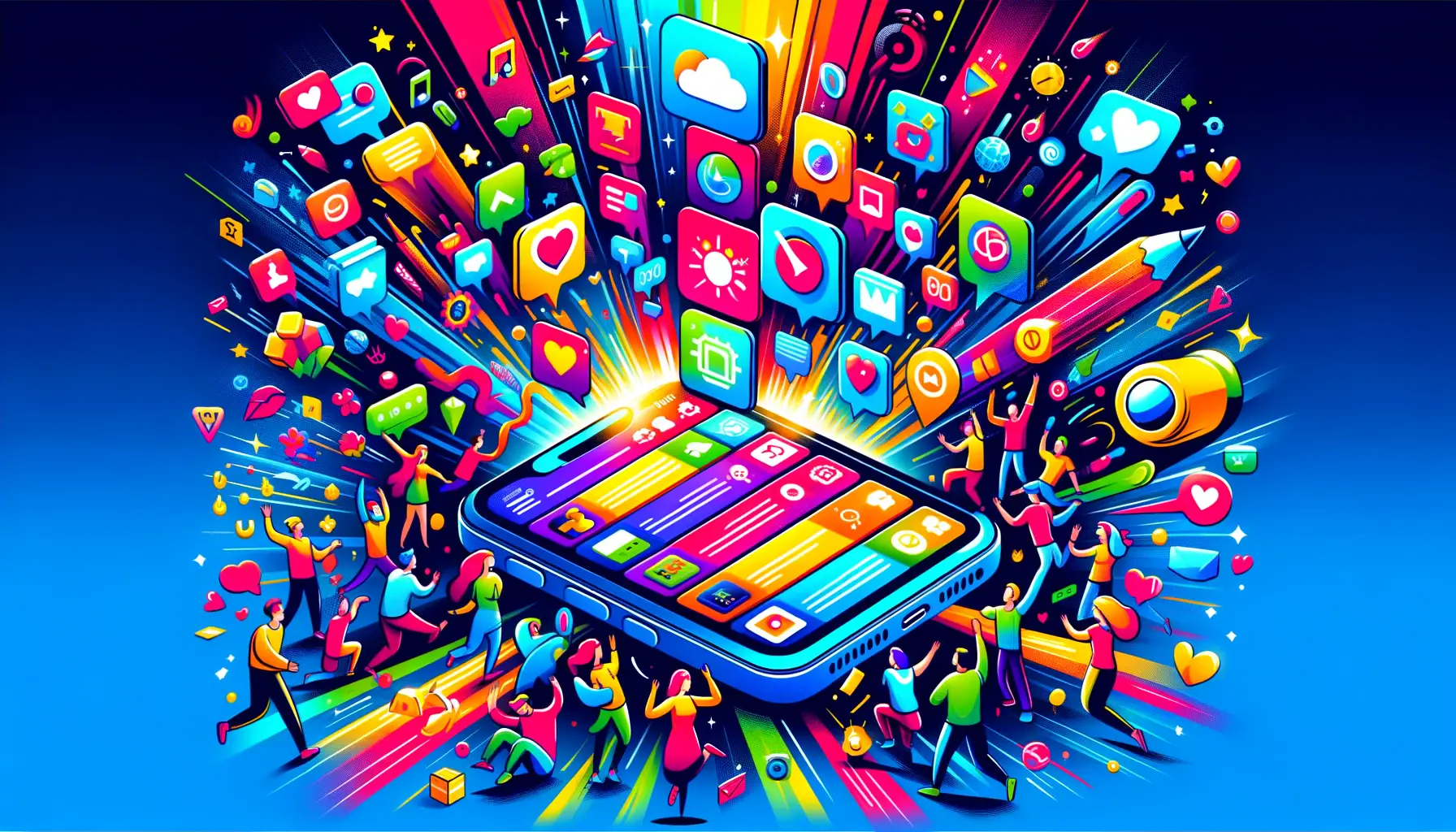The digital age has ushered in an era where app presence and visibility are paramount for success in highly competitive marketplaces.
Within this sphere, the significance of an app’s icon cannot be overstated.
This element serves not just as a visual representation of the app but as a critical tool for influencing user perception and engagement.
The process of evaluating icon success through A/B testing offers a methodical approach to understanding how slight variations in design can impact user interaction and app store optimization (ASO) outcomes.
App icons are the first touchpoint between an app and potential users, making their optimization a key aspect of an effective ASO strategy.
A/B testing, a scientifically structured experiment comparing two versions of an app icon to determine which one performs better in terms of user engagement and conversion rates, is instrumental in achieving this optimization.
This article delves into the nuances of conducting A/B tests for app icons, emphasizing their importance in enhancing app visibility and user acquisition.
- Understanding the Basics of A/B Testing
- Key Elements to Test in App Icons
- Designing for Different Platforms
- Measuring the Success of A/B Testing
- Incorporating User Feedback in A/B Testing
- Optimizing for Visibility and Conversion
- Continuously Refining Your App Icon
- Conclusion: Harnessing the Power of A/B Testing for Icon Success
- FAQs on A/B Testing for Icon Success
Understanding the Basics of A/B Testing
A/B testing, at its core, is a comparative analysis tool used to gauge user responses to two different versions of an app’s element, in this case, the icon.
This method involves exposing a segmented audience to two variations (A and B) while all other variables remain constant, to identify which version drives superior performance metrics such as click-through rates (CTR), downloads, and engagement levels.
A/B testing not only illuminates preferences within your target audience but also offers data-driven insights that can significantly optimize your app’s market position.
The efficacy of A/B testing lies in its simplicity and direct approach to problem-solving.
By systematically testing variations of an app icon, developers and marketers can refine their designs based on user feedback and interaction patterns.
This process demystifies the preferences of the app store audience, enabling the creation of more engaging and appealing icons tailored to the tastes and expectations of potential users.
Setting Up an Effective A/B Test
Creating a successful A/B test for app icons involves several key steps, beginning with the development of a hypothesis.
This hypothesis predicts the potential impact of one variant over another.
For instance, one might hypothesize that an icon with a brighter color scheme will attract more attention and, consequently, yield a higher CTR.
Following the hypothesis, the next step is to design two versions of the icon that differ in one major aspect—color, in this scenario—while ensuring everything else remains unchanged.
The selection of a relevant audience segment for the test is crucial, as it must represent the broader target market accurately.
The test is then rolled out to this segment, with performance metrics closely monitored to gather substantial data.
Analysis of this data reveals the more effective icon variant, guiding future design decisions.
Importantly, A/B testing should be an ongoing process, with successive tests refining the app icon to perfection.
A/B testing is a valuable tool for optimizing app icons, directly impacting an app’s success by enhancing user engagement and improving visibility in competitive app marketplaces.
Key Elements to Test in App Icons
While A/B testing offers a broad canvas for experimentation, focusing on specific elements within an app icon can yield more actionable insights.
Identifying which aspects of an icon to test is a pivotal step in the A/B testing process, as it directly influences the potential to improve app performance and user engagement.
The selection of elements for testing should be informed by both industry trends and intuitive design principles.
Here, we explore some of the key elements that are crucial for testing to ensure your app icon stands out in the crowded app marketplaces.
Color Scheme and Contrast
The color scheme of an app icon plays a significant role in attracting users’ attention.
Vibrant colors can make an icon pop against the backdrop of an app store, while a well-considered contrast can enhance legibility and icon recognition.
Testing different color combinations and contrast levels can reveal preferences that resonate with your target audience, potentially increasing the icon’s appeal and click-through rates.
Icon Imagery and Symbols
The imagery or symbols used in an app icon should clearly convey the app’s purpose or core functionality.
Whether it’s a simplified graphic, an abstract representation, or a character, the chosen imagery can significantly affect user perception.
A/B testing different imagery or symbols helps identify which visuals are most effective in communicating the app’s value proposition to prospective users.
Text Usage
Although not all app icons include text, incorporating a letter or word can sometimes clarify the app’s purpose, especially if the imagery alone is not immediately indicative.
Testing the presence of text, its font size, style, and placement can offer insights into how text elements contribute to an icon’s overall effectiveness and user engagement.
- Color Scheme and Contrast: Test variations in color palettes and contrast ratios to assess impact on visibility and user attraction.
- Icon Imagery and Symbols: Experiment with different graphics or symbols to determine which conveys the app’s functionality most intuitively.
- Text Usage: Evaluate the inclusion of text for clarity, experimenting with font styles, sizes, and positioning for optimal readability and appeal.
Each of these elements plays a crucial role in the overall effectiveness of an app icon.
By methodically testing variations of these elements, developers and marketers can refine their icons to better meet the preferences of their target audience, ultimately enhancing the app’s visibility and appeal in the competitive app marketplaces.
Remember, the goal of A/B testing app icons is to identify elements that significantly impact user engagement and app downloads, guiding the design towards higher conversion rates and success.
Designing for Different Platforms
The design and optimization of an app icon should take into account the specific requirements and user expectations of different platforms, namely the Apple App Store and Google Play Store.
Each platform has its own set of guidelines and best practices for app icons, influenced by the overall design language and user interface elements prevalent in their ecosystem.
Adapting your icon design to fit these nuances can significantly enhance its performance and visibility on each platform.
Apple App Store Icon Design
For the Apple App Store, icons must align with the principles of simplicity, clarity, and beauty that define iOS design.
Icons should utilize a minimalist approach, focusing on a single, central element that effectively communicates the app’s essence.
The use of subtle textures and gradients can add depth, while ensuring the icon remains recognizable even at smaller sizes.
Testing different designs on this platform can reveal how well an icon resonates with iOS users, who tend to value clean, aesthetically pleasing visuals.
Google Play Store Icon Design
In contrast, the Google Play Store caters to a more diverse range of devices and screen sizes, requiring icons to be more versatile.
Icons should be bold and straightforward, with vivid colors and clear imagery that stands out in a variety of contexts.
Android users often appreciate creativity and uniqueness in icon design, making it crucial to test designs that balance distinctiveness with clarity.
- Apple App Store: Focus on simplicity, clarity, and aesthetics. Utilize minimalistic designs with subtle textures and gradients.
- Google Play Store: Aim for boldness and versatility. Use vivid colors and clear, straightforward imagery that captures attention across diverse devices.
Understanding and designing for the nuances of each platform not only ensures compliance with their guidelines but also increases the likelihood of your app standing out.
A/B testing tailored to these platform-specific preferences enables you to refine your icon design effectively, maximizing its appeal and performance on both iOS and Android devices.
Consider the platform-specific user expectations and design languages when creating and testing app icons to ensure optimal visibility and user engagement.
Measuring the Success of A/B Testing
The ultimate goal of A/B testing app icons is to identify variations that lead to better performance in terms of user engagement, click-through rates (CTR), and conversions.
Measuring the success of these tests requires a clear understanding of the metrics to track and how to interpret them.
This part of the process is critical, as it informs decision-making and guides the iterative design improvements necessary for optimizing the app icon.
Key Metrics for A/B Testing
Several key performance indicators (KPIs) are essential for evaluating the outcome of an A/B test.
The primary metric is the click-through rate (CTR), which measures the percentage of users who click on the app icon out of the total who viewed it.
A higher CTR indicates a more appealing icon.
Conversion rate, which measures the percentage of users who download the app after clicking the icon, is another crucial metric.
Additionally, engagement metrics such as app open rates and retention rates can provide deeper insights into how the icon influences user behavior beyond the initial download.
Interpreting Test Results
Interpreting the results of an A/B test involves comparing the performance of the two icon variations across the selected metrics.
A statistically significant difference in performance indicates that one variant is more effective than the other.
However, it’s important to consider the context of these results and the potential reasons behind the differences.
For instance, an icon that performs well in terms of CTR but leads to lower retention rates may need further refinement to ensure it accurately represents the app’s content and value proposition.
- Click-Through Rate (CTR): Measures the effectiveness of the icon in enticing users to click and explore the app further.
- Conversion Rate: Assesses the icon’s impact on driving app downloads.
- User Engagement: Evaluates how the icon influences app open rates and retention rates, indicating long-term user interest and satisfaction.
Successfully measuring and interpreting the results of A/B testing empowers developers and marketers to make informed decisions, optimizing the app icon for better performance.
This data-driven approach ensures continuous improvement, adapting to user preferences and market trends for sustained app success.
Accurate measurement and analysis of A/B test results are fundamental for optimizing app icons, driving higher engagement, and improving overall app performance.
Incorporating User Feedback in A/B Testing
Beyond quantitative metrics, incorporating user feedback into the A/B testing process can provide valuable qualitative insights that enrich understanding and guide more nuanced icon optimizations.
User feedback sheds light on the reasons behind behavior patterns observed in A/B test metrics, offering a more comprehensive view of user preferences and expectations.
This approach involves gathering and analyzing user opinions and reactions to different icon designs to refine the testing process further.
Gathering User Feedback
There are several effective methods for collecting user feedback on app icons.
Surveys and questionnaires can be deployed to a targeted user segment, asking specific questions about their preferences and perceptions regarding the icon designs tested.
Social media platforms and app review sections also serve as rich sources of unsolicited feedback, where users often share their opinions and suggestions freely.
Additionally, conducting focus groups or user interviews provides in-depth insights into user attitudes and preferences, enabling a deeper understanding of the factors that influence their interactions with app icons.
Analyzing and Implementing Feedback
Once collected, user feedback must be systematically analyzed to identify common themes, preferences, and areas for improvement.
This analysis should inform subsequent iterations of A/B testing, with new variations designed to address the insights gained from user feedback.
Implementing changes based on this feedback and measuring the impact through further A/B testing cycles can significantly enhance the app icon’s effectiveness, leading to improved user engagement and app performance.
- Surveys and Questionnaires: Directly ask users about their preferences and views on the icon designs.
- Social Media and App Reviews: Monitor these platforms for unsolicited feedback and general user sentiment towards the app icon.
- Focus Groups and Interviews: Conduct in-depth discussions with users to gain detailed insights into their preferences and suggestions.
Incorporating user feedback into the A/B testing process not only validates the quantitative data collected but also provides a richer, more nuanced understanding of how different elements of an app icon resonate with users.
This holistic approach to icon optimization ensures that design decisions are grounded in actual user experiences and preferences, driving more effective and user-centric outcomes.
User feedback is a critical component of the A/B testing process, offering invaluable insights that complement quantitative data and drive more informed and effective icon optimizations.
Optimizing for Visibility and Conversion
The ultimate aim of refining an app’s icon through A/B testing is to optimize it for better visibility in app stores and to enhance conversion rates from views to downloads.
Achieving this requires a strategic approach that combines the insights gathered from A/B testing with best practices in icon design and app store optimization (ASO).
By focusing on creating an icon that stands out visually while accurately reflecting the app’s purpose, developers can significantly improve their app’s market performance.
Strategies for Enhanced Visibility
Enhancing an app icon’s visibility in crowded app marketplaces involves leveraging color, composition, and clarity to capture user attention.
Icons that use a distinct color scheme or unique design elements can differentiate an app from its competitors, making it more likely to be noticed by potential users.
Additionally, ensuring the icon is clear and recognizable even at smaller sizes is crucial for visibility on various screen sizes and resolutions.
Improving Conversion Rates
Once an app icon has captured a user’s attention, it must then persuade them to take the next step and download the app.
This involves creating an icon that not only looks appealing but also conveys the app’s value proposition at a glance.
Icons that incorporate imagery or symbols related to the app’s core functionality can help communicate its purpose and encourage users to explore further.
Testing different design elements can identify the most effective ways to convey this information and convert views into downloads.
- Utilize Unique Colors and Designs: Stand out in app stores with distinctive colors and creative design elements.
- Ensure Clarity at All Sizes: Design icons that remain clear and recognizable on different devices and screen resolutions.
- Convey App’s Purpose: Use imagery and symbols that reflect the app’s core functionality and value proposition.
By combining these strategies with the insights gained from A/B testing, developers can craft an app icon that not only captures user attention but also effectively communicates the app’s benefits, leading to higher conversion rates and overall success in the app marketplaces.
Ignoring the importance of optimizing app icons for visibility and conversion can lead to missed opportunities in engaging potential users and achieving app store success.
Continuously Refining Your App Icon
The mobile app marketplace is dynamic, with user preferences and design trends constantly evolving.
To maintain and enhance app visibility and engagement, it’s crucial to adopt a mindset of continuous improvement for your app icon.
This approach involves regularly reviewing performance data, staying updated on design trends, and being receptive to user feedback.
A/B testing plays a pivotal role in this process, providing a structured framework for experimenting with new designs and measuring their impact.
Staying Ahead of Design Trends
Keeping abreast of current design trends is essential for ensuring your app icon remains appealing and relevant to users.
This involves researching design innovations, monitoring successful apps in your category, and experimenting with new design elements that could enhance your icon’s attractiveness.
However, while embracing trends, it’s important to maintain consistency with your app’s branding and core message, ensuring that the icon remains true to the app’s identity.
Leveraging Performance Data and Feedback
Performance data and user feedback are invaluable resources for guiding the continuous refinement of your app icon.
Analyzing metrics such as CTR and conversion rates can identify areas for improvement, while user feedback can offer insights into how your icon is perceived by your target audience.
Integrating these insights into your design process enables you to make informed decisions, ensuring that each iteration of your icon is better aligned with user preferences and expectations.
- Monitor Design Trends: Stay informed about the latest design trends and consider how they can be applied to your app icon to keep it fresh and appealing.
- Analyze Performance Data: Regularly review key metrics to understand how your icon is performing and identify potential areas for optimization.
- Collect and Act on User Feedback: Use feedback from your users as a direct source of inspiration for refining your app icon, making sure it resonates well with your audience.
Embracing a philosophy of continuous improvement and leveraging the tools and insights available can ensure that your app icon not only captures attention but also remains a compelling gateway to your app.
By iteratively refining your icon based on solid data and current trends, you can sustain and grow your app’s success in the competitive app marketplace.
Continuous refinement, guided by A/B testing, user feedback, and performance data, is key to maintaining an effective and engaging app icon that adapts to changing user preferences and market trends.
Conclusion: Harnessing the Power of A/B Testing for Icon Success
In today’s competitive app marketplace, standing out requires more than just a functional app—it demands a visually appealing and instantly recognizable app icon.
Through the strategic application of A/B testing, developers and marketers can significantly enhance icon success, optimizing visibility and user engagement.
This article has explored the multifaceted approach to evaluating and refining app icons, highlighting the importance of continuous iteration and responsiveness to user feedback.
Key Takeaways for Maximizing Icon Success
The journey to optimizing an app icon through A/B testing is intricate, requiring attention to detail, a deep understanding of user preferences, and an adaptive design strategy.
Some of the key takeaways include:
- The importance of defining clear, measurable objectives for A/B testing to ensure focused and actionable results.
- Selecting and testing specific elements of the icon—such as color scheme, imagery, and text—can reveal powerful insights into user preferences.
- Adapting icon designs to meet the unique guidelines and user expectations of different platforms, such as the Apple App Store and Google Play Store, enhances overall effectiveness.
- Measuring success through a combination of quantitative metrics and qualitative user feedback informs a comprehensive optimization strategy.
- Staying abreast of design trends and continuously refining the app icon based on performance data and user feedback ensures sustained success in the app marketplace.
In conclusion, the meticulous application of A/B testing to app icon design is not just a strategy for incremental improvement—it is a fundamental component of a successful app marketing plan.
By embracing the principles outlined in this article, developers and marketers can elevate their icon success, driving higher visibility, engagement, and conversions.
The path to a standout app icon is iterative, data-driven, and user-focused, embodying the essence of modern app store optimization strategies.
Embracing the Future of App Icon Design
As we look to the future, the evolution of app icon design and optimization will continue to be shaped by technological advancements, changing user behaviors, and emerging design philosophies.
However, the core principles of A/B testing—empirical analysis, user-centric design, and continuous improvement—will remain central to achieving icon success.
By leveraging these strategies effectively, app developers and marketers can ensure that their icons not only capture attention but also encapsulate the spirit and value of their apps, forging stronger connections with users in an ever-evolving digital landscape.
Boost your mobile app's success with our guaranteed App Store Optimization (ASO) service. Leave it to the experts!
FAQs on A/B Testing for Icon Success
Delving into A/B testing for app icons unveils a plethora of questions aimed at optimizing icon design for maximum engagement and success. Here are some frequently asked questions to guide your A/B testing journey.
A/B testing for app icons compares two versions of an icon to determine which performs better in engaging users and encouraging downloads.
It allows developers to make data-driven decisions that enhance user engagement and optimize the app’s visibility in the marketplace.
Focus on elements like color scheme, imagery, and presence of text, as these significantly impact user perception and interaction.
Yes, by optimizing icon design for higher engagement, A/B testing can indirectly influence your app’s ranking in store search results.
A/B tests typically run for 1-2 weeks, but the duration may vary depending on the volume of traffic and the clarity of results.
Key metrics include click-through rates (CTR), conversion rates from views to downloads, and user feedback on icon preference.
Gather feedback through surveys, app reviews, and social media to inform future icon designs and A/B testing strategies.
Yes, design preferences and guidelines vary between platforms like iOS and Android, influencing how users perceive and interact with icons.




